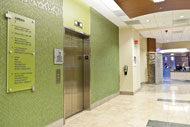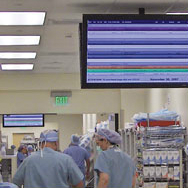
The delivery method and practices associated with health care services have continually evolved, but they often cause disruption and uncertainty that can undermine staff morale. It is clear that there is no single solution to this problem; it takes a combination of initiatives to bring costs under control. One area with significant potential for cost reductions using existing technology is greater efficiencies in communications both internally to staff and externally to patients and visitors. Managing the flow of data to place the right information in front of the right people at the right time can produce dramatic results. One such method of achieving improved communications among staff, patients and visitors, which many hospitals have adopted, is through the use of digital signage.
Digital signage is a form of visual communications that can inform, educate, build awareness, create relationships and facilitate decisions. There are a lot of digital signage products on the market today with a wide range of capabilities, ranging from simple electronic posters to sophisticated data delivery models. With a data-driven approach, digital signage systems can streamline processes, assist with decision-making, and ultimately influence behavior among viewers.
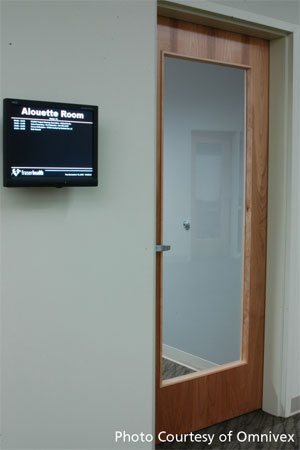
Fraser Health has networked its meeting room signs so they update automatically.
Ironically, this highlights one of the big obstacles with digital signage deployments. Many people see digital signage as a unidirectional platform to post general messages to a broad audience. Subsequently, it is usually limited to either wayfinding applications or donor appreciation walls. But the potential is much greater. When you approach digital signage as a communications tool, your focus will change to internal staff, patients and their interaction. It is not an either/or proposition. Patients are an active participant in their care, there is specific information that needs to target to them and the delivery of that information has an impact on the health provider's actions. Communicating pertinent information to patients upon their arrival to the hospital can save a lot of time in the admissions process.
An example of how digital signage would have streamlined efforts if it had been a part of the communication strategy was in April 2003, when the city of Toronto had to deal with a major threat from a SARS severe acute respiratory syndrome (SARS) outbreak. With three levels of government involved and the world watching, health services had to respond quickly. New patient screening procedures had to be put in place and communicated to both staff and patients at medical facilities throughout the region in a consistent and coordinated manner. Communicating the new procedures via digital signage would have been extremely beneficial in terms of time and efficiencies. New procedures could have been displayed immediately across the health care infrastructure and updated in real-time, allowing staff to focus on areas where they provide greater value and reduces anxiety for the patient.
Where to start
So how do you build a communication conduit that informs patients and staff empowering them to make a difference? To start, you need to define processes in terms of communication or data flow. This applies to everyone, including doctors, nurses, administration, custodians, patients and visitors. Look at each area of the health care facility to understand the traffic flow and determine what information is required by each type of audience to take appropriate action.
Information should move with people, you should never have to go in search of it. Eliminating the paper that moves with a patient, requiring input from multiple people and replacing it with an information delivery system that responds to a unique identifier such as a bar code or radio-frequency identification (RFID) tag in a patient bracelet can eliminate potential errors. Placing large screens at strategic locations provides a quick reference to staff on what procedures are scheduled in which rooms and what is the current stage of those procedures. Schedules for operating rooms impact a lot of people with different functions at different times and the length of a procedure can vary. Doctors and nurses need to be informed about what procedures, staff and patients are in each of the operating rooms, but the cleaning crew also needs to know when operating rooms are ready for cleaning.
Digital signage can make information available to an audience at the moment when they need it to make a decision. By giving staff access to information about immediate conditions, you give them a reason to change their behavior and focus on improving results. Involving participants to achieve intended outcomes can result in new innovative practices that streamline procedures.
Live data and new thinking
Digital signage on large format displays is becoming commonplace in retail stores, airports, hotel lobbies or anywhere people congregate. These are simply visual communication tools that smart business owners use to disseminate information to their audience. Although most digital signage software products provide simple playback of recorded messages, there are software solutions that focus on delivering real-time information (data) from a variety of sources. There is no lack of data in most organizations; the challenge is making your information actionable.
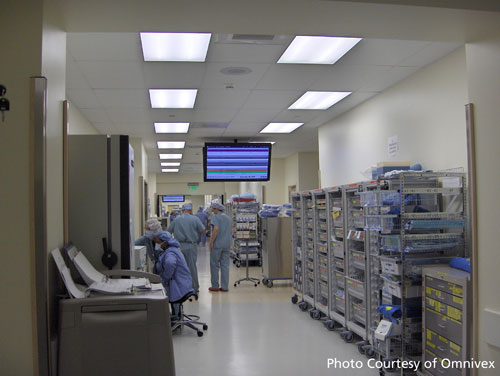
St Joseph's Hospital in California communicates critical information about scheduled procedures to its internal staff, using overhead LCDs.
By combining a visual medium like digital signage with an effective information procurement system, you can leverage existing assets to reduce operating costs and increase the quality of service delivered. Relevant information may originate from a combination of databases, scheduling software or tracking systems, such as the bar codes and RFID tags referenced earlier or the patient information database. This data can either be interpreted to display or trigger information to be displayed that is specific to the time, place or situation. Scanning a patient bracelet can trigger data retrieval from a central database. If the information that appears on the digital signage system does not match the patient's chart, you know that you have a problem.
Visual data sharing
A good example is St. Joseph Hospital, a 3,800-employee health care facility in Orange County, Calif. In a large hospital, a great deal of coordination is required to move patients through the operating facility seamlessly, from pre-operative through to the recovery area. Which treatment rooms are available? Which patients are ready for surgery? Has a procedure in an operating room been completed ahead of schedule and can that operating room be prepared for the next surgery? Tracking each patient and coordinating resources requires staff to have immediate access to information. While this information exists at desktop workstations through the patient information management systems, St. Joseph's staff has immediate access to it on large display screens mounted strategically around the facility and supported by a digital signage software solution.
Making information readily accessible to health care workers is an important part of ensuring efficient delivery of services, but how do we ensure accuracy and speed? Linking the information source directly to the delivery system alleviating the need for any additional data entry is critical. If information is handled and interpreted by multiple people, you run the risk of inconsistency, delays and errors. Digital signage makes information visible through a process that is transparent to the viewer. The information that is specific to a time and space is available to the viewer without going to a workstation or having to search.
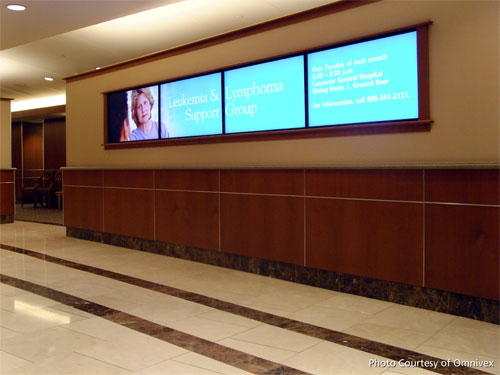
Lancaster PA General Hospital's donor walls raise awareness of health care issues for visitors, using LCD tile matrix and software.
Graphical depictions can be easier to understand across multiple functions. As a visual cue, St. Joseph Hospital uses color coding on the displays to provide status updates related to each patient case (e.g. patient ready in pre-operative holding area or surgery in progress) helping staff to have improved focus on their individual responsibilities and to signal availability of treatment rooms. The digital signage software allows for content to be automatically sent to the appropriate screens and for the system to be centrally managed, so the system and information from one query can automatically be routed to multiple locations ensuring consistent, accurate and timely communication.
Information processing
Digital signage provides a mechanism to view the amalgam of a large amount of data in a simple yet intuitive format. It is much easier to spot trends or identify situations using effective graphics. Unlike the last PowerPoint presentation that you had to endure, this information is in real-time, up to the second and specific to what is happening around you. Color-coding, arrows, icons and gauges provide instant comprehension. Digital signage can provide a unique dashboard for each area. With a quick glance, you have a clear indication of the present status at that location, what is coming and what has passed.
There are various ways that you can apply this capability. If you track the progress of each patient through his or her visit, you can create dynamic images on each screen mapping the upcoming workload. Staff can quickly identify hot spots and focus their attention where it provides the best results. Patients and visitors can be informed of current status information without breaching privacy or confidentiality laws, allowing staff to do their jobs with fewer interruptions. Facility information can be provided in an interactive format or traditional digital signage. The ability to move patients and visitors to the appropriate area of the hospital, without involving staff resources, improves the utilization of your professional staff while reducing stress for the patient and visitors. An added benefit of using a digital signage system is that messages or images can be multilingual. If visitors can receive their instructions in multiple languages or in the form of simple graphics, it is one less distraction for your staff.
Hospitals can be very large and complex places to navigate. During an emergency, your staff needs to focus on patients. Data inputs are not limited to databases and RSS feeds, Contact closures and IO serial controls can trigger content to play in designated areas. By tying into the hospital's emergency detection systems (such as fire detection), your digital signage system can act as an extension of your emergency alert system responding to alarms to evacuate a facility and indicating the nearest exit from that point.
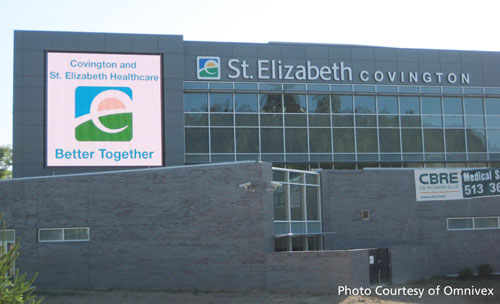
St Elizabeth Health Care in Kentucky uses a giant LED board to welcome visitors and communicate key messages.
The case for quality
Digital signage is common in manufacturing operations under ISO standards where employee involvement is considered a driver towards continuous improvement. In health care services, there is a similar move to report performance levels against standards; however, additional criteria must be considered due to ethical, political and economic concerns. A digital information system reports information directly to staff without the need for mind-numbing amounts of paperwork, spreadsheet manipulation and formatting for review. When the feedback is linked directly to your measurement tracking system, reporting avoids delays and potential errors.
A properly configured digital signage system can extract the information and post it to the screens in the appropriate location, in real time. This is a highly visible way to demonstrate that processes and workflow are central to the organization, and makes a positive impression on those who are charged with evaluating quality of work. The signage becomes yet another checkpoint to help staff verify accuracy of assignments, prepare for the next patient and track performance of the facility.
Replacing a manual system with an automated system can also reduce audit preparation costs by eliminating unnecessary documentation. Additionally, these systems can also be impressive for patients. Both compliance audits and patient tours are that much more impressive when people observe workers armed with real information about service quality and scheduling.
Added value
There is additional value beyond the short-term benefits of improving the day-to-day workflow within a facility. Improving morale and giving staff a sense of their role in a complex team environment is crucial in the health care industry. Health care professionals are working longer hours to service more patients in a shorter period of time. Building and reinforcing a strong team culture requires clear communication of values and measurement of how the organization is progressing toward goals. Digital signage can have a huge motivational impact on your staff and ensure that everyone receives the most accurate and up-to-date information possible, helping them to make the right decisions quickly and become involved in the entire organization's success.
Jeff Collard is president of Omnivex Corp., a developer of enterprise-wide software that manages all aspects of digital signage networks. He can be reached at jcollard@omnivex.com.



